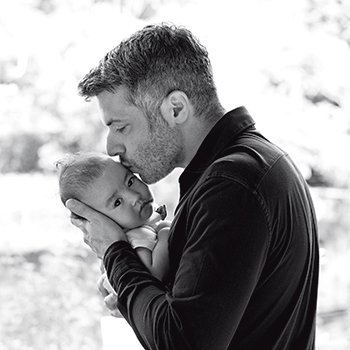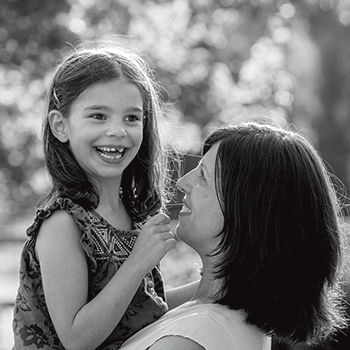Blog posts from two parents
A Symphony Amidst the Suffering

By Will Greene ’06
After weeks of anxious waiting, my partner and I received news last week that little Ari tested positive for Prader-Willi Syndrome (PWS), a rare and potentially serious condition that explains his low birth weight, weak muscle tone, inability to cry and other developmental delays. While various treatments now exist to limit the disease’s impact, it poses major risks to our son’s health and presents a lifetime of challenges that are difficult to contemplate.
PWS is a congenital condition in which a chromosomal defect interferes with the regular function of the hypothalamus, a portion of the brain that controls the release of hormones that regulate hunger, growth, mood and sexual development. Common features of PWS include learning disabilities, infertility, physical weakness, emotional problems and compulsive overeating that can lead to morbid obesity if not carefully controlled. With early intervention and careful management, a subset of PWS patients have a decent shot at living full, independent lives, but virtually all will face major obstacles along the way.
From the moment he arrived, Vy and I knew that Ari was not a normal baby. We experienced frequent spells of deep foreboding. We struggled with complex medical decisions that were difficult to manage in the face of acute emotional turmoil. At night, I slept fitfully. During the day, I often felt too nauseated to eat. Periodically, a cold shudder would rip through my body and leave me feeling like my heart was in a vise grip.
Before my son’s birth, I dreamed of coaching him to be a top-of-class student, taking him on outdoor adventures in exotic places, and teaching him to appreciate the beauty of the arts and the power of the sciences. Suddenly, all this felt like it was no longer on the table.
I felt a crushing fear about the financial and emotional toll that this condition would bring. Less rational emotions came up, too. There was anger—at the doctors who delivered the news with imperfect empathy, at the hospitals that inflated our bills with petty charges, at my insurance company for their spotty coverage, at the universe for dealing me such a garbage hand in the game of life. There was shame, as though all of this was somehow my fault, reflecting poorly on my genetic qualities or representing some kind of karmic comeuppance.
I also felt deeply motivated. Before Ari’s birth, I recall long stretches of pandemic-induced apathy in which I would spend hours compulsively checking and rechecking my email, or trawling the trashiest recesses of social media for the smallest morsels of inspiration and validation. In recent weeks, however, I was propelled by an intense focus and sense of purpose.
Music has been a source of hope and comfort. During Ari’s first trip to the NICU, I found myself repeatedly listening to Gustav Mahler’s 9th symphony, a work of extraordinary power and beauty that is widely ranked among the greatest orchestral works ever composed. Mahler wrote it at a time of almost inconceivable stress—just months after his beloved 4-year-old daughter died and his physician diagnosed him with a fatal heart disease.
The enduring legacy of this transcendent work shows that epochal accomplishments are possible in the face of tremendous suffering. But our journey is only just beginning, and hope is fleeting. Perhaps, as we learn more, that hope will burn brighter.
On the Outside Looking In

By Julia Vitarello ’99
Today, a friend of mine sent me a text saying that her daughter came home from school and asked why a picture of Mila was posted in her elementary school. My friend asked if I knew about this. I didn’t. When I read the text, it confused me at first, almost made me smile to know that a photo of my sweet Mila bug was posted on a wall for everyone to see. It brought me back to a similar moment when Mila was just 1. We were heading to our baby tumbling class when I happened to spot a poster on the wall with a photo of Mila smiling up at the camera. At the time, it made me laugh and feel proud that someone chose my smiley little girl to use on their poster. I grabbed a copy and stuffed it away in my “Mila” folder back at home.
When I read my friend’s text, my heart went to that same place of pride. But then it dropped and I cried. I imagined students Mila’s age racing down the hallways past Mila’s photo with their backpacks on, maybe heading to their classroom or to recess or the cafeteria. All things that Mila may never know in her life. Things even I, as her mom, know nothing about. What do 6-year-olds do at school these days? Do they write sentences in those black-and-white notebooks? Do they read stories? Do they learn about other countries? I hate going to that place, thinking about the kids she used to call friends. The ones that used to swarm around her, who would want to run around the house with her, to jump off the bed with her, to dress up like fairies and princesses with her. The memory is painful. It doesn’t make me feel anger. The feeling just forms into a giant wave of pain, of a sadness that’s hard to describe, which covers me, suffocates me. A sadness for Mila, for us as a family, for the life I always assumed we would have. Why wouldn’t we?
Since receiving Mila’s diagnosis of Batten disease just two months ago, I have avoided looking back at photos, or opening up our Mila folder in our old wooden filing cabinet. But today I decided to look. I found the poster of Mila from the tumbling class. It made me instantly smile. She really was so cute, so radiant. I found a stack of colored construction paper with squiggly marker lines across them, feathers, glitter, cotton balls, preschool teacher’s handwriting: “To mommy.” And then I found a slightly browned cover of Boulder’s newspaper, the Daily Camera, from November 2012. There was Mila, 2 years old, decked out in her brightly colored, paint-splashed snowsuit with furry lined hood, standing in the snow and smiling up at the camera once again. I remembered all of the cute photos included online with the article—photos of a girl full of life, kicking piles of snow and climbing up onto the planters on Pearl Street. I stuffed the papers back in, and added to the top a copy of the Daily Camera from last month. The title stared up at me: “Boulder County Girl Diagnosed with Batten Disease.” I felt my breath push out of my chest. I closed the folder and stuck it down into the filing cabinet.
Sometimes I feel like I’m on the outside looking in. That I’m watching someone else’s little girl on the news, reading about her in articles, walking past her photo in a hallway and feeling tears well in my eyes at the thought of that terrible thing happening to my family. And then trying to convince myself that I can’t take on the world’s burdens, something I’ve always struggled with. I can’t make the sadness of what this family is going through my story or my life. I just need to feel sad and move on. But then I wake up, as if I’ve been slapped in the face, and look at myself in the mirror. This is my life. This is my daughter who is dying. This is my son whose future dangles in limbo. I breathe deeply, and warm tears pour down my cheeks. I lift my chin as I hear giggles coming from the other room. I smile at what I have today. And hope for what tomorrow may bring.
Photos by Kate Mitchell and Jewel Afflerbaugh